对于ACCA考试科目中F8的题型分析
- 格式:doc
- 大小:20.30 KB
- 文档页数:3
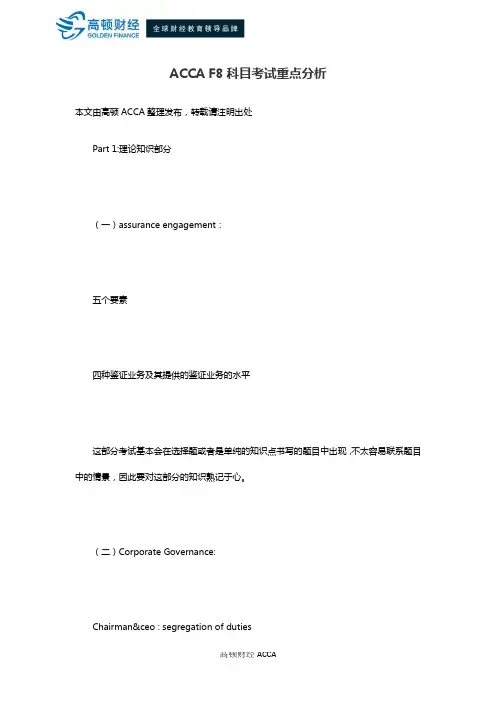
ACCA F8科目考试重点分析本文由高顿ACCA整理发布,转载请注明出处Part 1:理论知识部分(一)assurance engagement:五个要素四种鉴证业务及其提供的鉴证业务的水平这部分考试基本会在选择题或者是单纯的知识点书写的题目中出现,不太容易联系题目中的情景,因此要对这部分的知识熟记于心。
(二)Corporate Governance:Chairman&ceo : segregation of dutiesED&NED:BalanceNED supervise ED’s work Audit committee Remuneration committee Nomination committee Risk committee关于公司治理方面,一般以情景题的形式考察大家对于知识点的理解,因此在读题目的时候,凡是违背CG要求的都是公司治理的薄弱环节,提出的改善意见就是我们介绍的CG 的准则。
(三)Professional Ethics:IntegrityObjectivesCompetence and due careConfidentialProfessional behavior对应的在这部分要掌握的还有五个threat:FamiliaritySelf-interestSelf-reviewAdvocacyIntimidation与之相对应的safeguard:Disposal(股票等资产),independent third party review,report to audit committee,rotation,resignation,refuse这部分内容每年必考,首先对于五个基本的职业道德,你要会解释定义,另外,五种威胁你要会判断并且写出相应的safeguard。
Part 2:审计实践第一步:Acceptance of a clientLowballing的概念Client screening的概念Engagement letter:written form,terms of responsibilities of mgt and auditors, known by mgt and auditors.基础的概念要了解是什么意思,会写定义,对于审计鉴证业务约定书,要明确这个约定书的内容以及签订的目的第二步:Understanding the business需要掌握的知识点有:Fraud:区别fraud与human error的,明确mgt和external auditors对于fraud 的不同责任interim audit与final audit的区别Business risk与audit riskmateriality:定义,计算基准,benchmarkDocumentation: permanent和current audit files的区别这部分知识点经常在历年考题的Q3中出现,给你一个情景,让你找到这个被审计客户的audit risk并且写出审计人员的应对方案,我们说凡是涉及到企业的新的改变,比如上马一套新的应用系统,制定一个新的策略,都是我们审计需要关注的地方,都是audit risk容易产生的地方,尤其要对涉及到的相应的会计准则的处理非常熟悉。
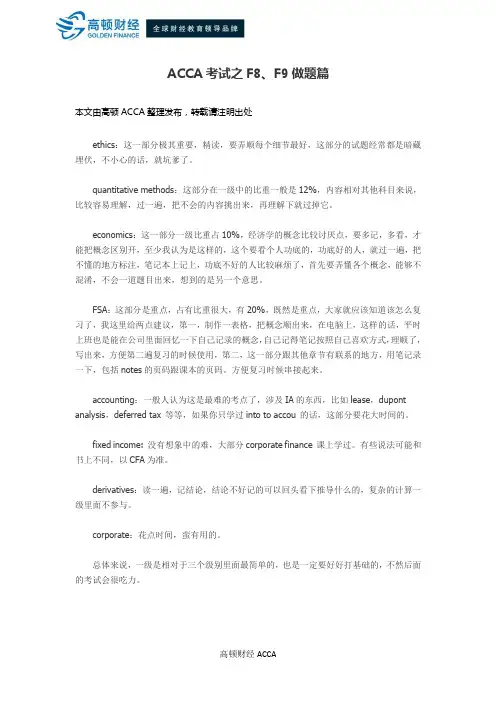
ACCA考试之F8、F9做题篇本文由高顿ACCA整理发布,转载请注明出处ethics:这一部分极其重要,精读,要弄顺每个细节最好,这部分的试题经常都是暗藏埋伏,不小心的话,就坑爹了。
quantitative methods:这部分在一级中的比重一般是12%,内容相对其他科目来说,比较容易理解,过一遍,把不会的内容挑出来,再理解下就过掉它。
economics:这一部分一级比重占10%,经济学的概念比较讨厌点,要多记,多看,才能把概念区别开,至少我认为是这样的,这个要看个人功底的,功底好的人,就过一遍,把不懂的地方标注,笔记本上记上,功底不好的人比较麻烦了,首先要弄懂各个概念,能够不混淆,不会一道题目出来,想到的是另一个意思。
FSA:这部分是重点,占有比重很大,有20%,既然是重点,大家就应该知道该怎么复习了,我这里给两点建议,第一,制作一表格,把概念顺出来,在电脑上,这样的话,平时上班也是能在公司里面回忆一下自己记录的概念,自己记得笔记按照自己喜欢方式,理顺了,写出来,方便第二遍复习的时候使用,第二,这一部分跟其他章节有联系的地方,用笔记录一下,包括notes的页码跟课本的页码。
方便复习时候串接起来。
accounting:一般人认为这是最难的考点了,涉及IA的东西,比如lease,dupont analysis,deferred tax 等等,如果你只学过into to accou 的话,这部分要花大时间的。
fixed income: 没有想象中的难,大部分corporate finance 课上学过。
有些说法可能和书上不同,以CFA为准。
derivatives:读一遍,记结论,结论不好记的可以回头看下推导什么的,复杂的计算一级里面不参与。
corporate:花点时间,蛮有用的。
总体来说,一级是相对于三个级别里面最简单的,也是一定要好好打基础的,不然后面的考试会很吃力。
更多ACCA资讯请关注高顿ACCA官网:。

对于ACCA考试科目中F8的题型分析关于ACCA考试科目中,各科都考哪些题型呢?中公财经网小编就以F8为例给大家简单介绍一下吧。
(一)客观题(Objective test questions/OT questions)客观题是指这些单一的,题干较短的,并且自动判分的题目。
每道客观题的分值为2分,考生必须回答的完全正确才可以得分,即使回答正确一部分,也不能得到分数。
(二)案例客观题(OT case questions)案例客观题是ACCA引入的新题型,每道案例客观题都是由一组与一个案例相关的客观题组成的,因此要求考生从多个角度来思考一个案例。
这种题型能很好的反映出考生将如何在实践中完成这些任务。
案例客观题会出现在2016年9月份的笔试中,这意味着CBEs考试和笔试的格式在本次考试中将完全一致。
(三)主观题(Constructed response questions/CR qustions)考生将使用电子表格程序和文字处理程序去完成主观题的回答。
就像笔试中的主观题一样,答案最终将由专家判分。
今天就奉上同学回忆出的12月ACCA F8科目考试真题,勇敢的童鞋赶紧来测试一下,你到底能否考过F8吧!Section A部分真题第一道案例选择题印象比较深,是关于professional ethical,考了fundamental professional ethical 和threat。
第二道是关于payroll system,考了audit procedure,completeness,understatement test,其中还有一道计算payroll expense。
第三道问了audit opinion,还有SP,有overstatement test。
Section B部分真题第一道大题,有16分的audit risk(identify and response)找出8个,factors toconsider set up internal audit department 4分,how internal audit effecton fraud and errors 2分,SP hot review and cold review 4分,SP for wages andsalary on completeness and existence 4分。
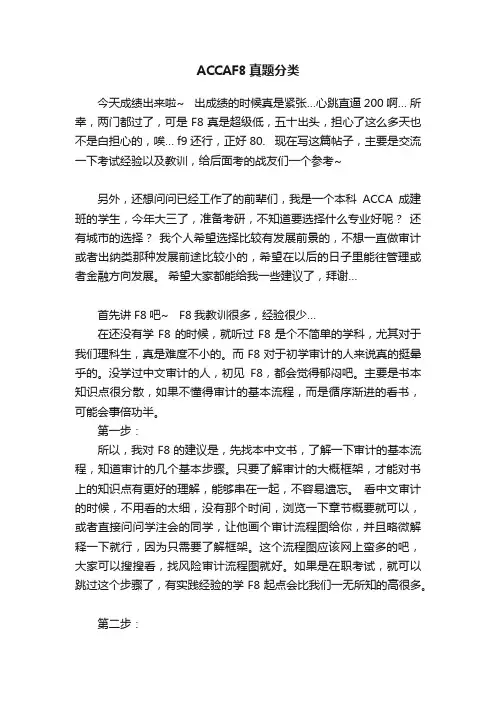
ACCAF8真题分类今天成绩出来啦~ 出成绩的时候真是紧张…心跳直逼200啊… 所幸,两门都过了,可是F8真是超级低,五十出头,担心了这么多天也不是白担心的,唉… f9还行,正好80. 现在写这篇帖子,主要是交流一下考试经验以及教训,给后面考的战友们一个参考~另外,还想问问已经工作了的前辈们,我是一个本科ACCA成建班的学生,今年大三了,准备考研,不知道要选择什么专业好呢?还有城市的选择?我个人希望选择比较有发展前景的,不想一直做审计或者出纳类那种发展前途比较小的,希望在以后的日子里能往管理或者金融方向发展。
希望大家都能给我一些建议了,拜谢…首先讲F8吧~ F8我教训很多,经验很少…在还没有学F8的时候,就听过F8是个不简单的学科,尤其对于我们理科生,真是难度不小的。
而F8对于初学审计的人来说真的挺晕乎的。
没学过中文审计的人,初见F8,都会觉得郁闷吧。
主要是书本知识点很分散,如果不懂得审计的基本流程,而是循序渐进的看书,可能会事倍功半。
第一步:所以,我对F8的建议是,先找本中文书,了解一下审计的基本流程,知道审计的几个基本步骤。
只要了解审计的大概框架,才能对书上的知识点有更好的理解,能够串在一起,不容易遗忘。
看中文审计的时候,不用看的太细,没有那个时间,浏览一下章节概要就可以,或者直接问问学注会的同学,让他画个审计流程图给你,并且略微解释一下就行,因为只需要了解框架。
这个流程图应该网上蛮多的吧,大家可以搜搜看,找风险审计流程图就好。
如果是在职考试,就可以跳过这个步骤了,有实践经验的学F8起点会比我们一无所知的高很多。
第二步:在知道审计的基本流程之后呢,就开始看书了。
一些重点的概念,一定要背下来,而且以书本的概念为主,真题给出的答案为辅。
(此处插播一点段,大家别觉着乱啊…我表达能力实在不太好,想到哪写到哪,型散而神不散的境界实在是望尘莫及,大家将就着看看。
之前我有写过F7的学习经验,在那里,我是崇尚不用看书,把练习册过几遍就够了。
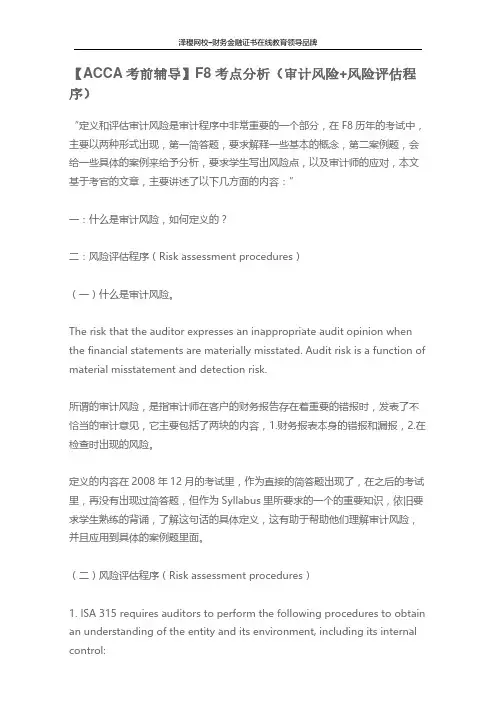
【ACCA考前辅导】F8 考点分析(审计风险+风险评估程序)“定义和评估审计风险是审计程序中非常重要的一个部分,在F8历年的考试中,主要以两种形式出现,第一简答题,要求解释一些基本的概念,第二案例题,会给一些具体的案例来给予分析,要求学生写出风险点,以及审计师的应对,本文基于考官的文章,主要讲述了以下几方面的内容:”一:什么是审计风险,如何定义的?二:风险评估程序(Risk assessment procedures)(一)什么是审计风险。
The risk that the auditor expresses an inappropriate audit opinion when the financial statements are materially misstated. Audit risk is a function of material misstatement and detection risk.所谓的审计风险,是指审计师在客户的财务报告存在着重要的错报时,发表了不恰当的审计意见,它主要包括了两块的内容,1.财务报表本身的错报和漏报,2.在检查时出现的风险。
定义的内容在2008年12月的考试里,作为直接的简答题出现了,在之后的考试里,再没有出现过简答题,但作为Syllabus里所要求的一个的重要知识,依旧要求学生熟练的背诵,了解这句话的具体定义,这有助于帮助他们理解审计风险,并且应用到具体的案例题里面。
(二)风险评估程序(Risk assessment procedures)1. ISA 315 requires auditors to perform the following procedures to obtain an understanding of the entity and its environment, including its internal control:。

总体评价:本次考试包括5个必答题。
A部分包括30分的问题1和10分的问题2。
B 部分包括三个更深入的问题,每题20分。
大部分考生完成了5个题目,然而还是有少部分没有完成问题的考生,这表明考试是有时间压力的。
General CommentsThe examination consisted of five compulsory questions.Section A contained question 1 for 30 marks and question 2 for 10 marks.Section B comprised three further questions of 20 marks each.The majority of candidates completed all five questions;however there was some evide nce of time pressure as a significant minority of candidates did not attempt all questions.T his seemed to mainly occur for question 5 or for the questions candidates found challengi ng,which are listed below.In addition a significant minority answered question 1 last and t heir answers were often incomplete.As question 1 is the case study and represents 30 of t he available marks,leaving this question until last can be a risky strategy,as many answers presented were incomplete or appeared rushed.Candidates performed particularly well on questions 1b,2c,3ci and 4bi.The questions c andidates found most challenging were questions 1a,2b,3a,3cii and 5b.This was mainly due to a combination of failing to read the question requirement carefully and insufficient kn owledge.A number of these areas were new to the F8 study guide in 2010 and hence as new topic areas should have been prioritised by candidates.A number of common issues arose in some candidate’s answers:•Failing to read the question requirement clearly and therefore providing irrelevant ans wers which scored few if any marks•Providing more than the required nu mber of points•Illegible handwriting and poor layout of answers.Specific CommentsQuestion OneThis 30-mark question was based on a retailer of ladies clothing and accessories,Grey stone Co,and tested candidates’ knowledge of internal control defi ciencies,trade payables an d internal audit.Part (a) for 5 marks required candidates to explain examples of matters that the audit or should consider in determining whether an internal control deficiency was significant.This part of the question was unrelated to the Greystone Co scenario and hence teste d candidates’ knowledge as opposed to application skills.This question related to ISA 265 Communicating Deficiencies in Internal Control to those Charged with Governance and Ma nagement,which is a new ISA and new to the F8 study guide for 2010.Most candidates performed inadequately on this part of the question.The main reason for this is that candidates failed to read the question properly or did not understand what the requirement entailed.The question asked for matters which would mean internal control deficiencies were significant enough to warrant reporting to those charged with governanc e.The question was not asking for examples of significant internal control deficiencies,how ever this is what a majority of candidates gave.Many answers included a long list of cont rol deficiencies such as “inadequate segregation of duties” this failed to score marks as it was not answering the question.It was apparent that many candidates had not studied the area of significant control d eficiencies,and as there is now an ISA dedicated to this area,this was unsatisfactory.Part (b) for 14 marks required a report to management which identified and explained four deficiencies,implications and recommendations for the purchasing system of Greyston e Co.A covering letter was required and there were 2 presentation marks available.This part of the question was answered well by the vast majority of candidates with some scoring full marks.The scenario was quite detailed and hence there were many possi ble deficiencies which could gain credit.Where candidates did not score well this was mai nly due to a failure to explain the deficiency and/or the implication in sufficient detail.So me candidates simply listed the information fr om the scenario such as “purchase invoices are manually matched to GRNs” and then failed to explain the implication of this for Gre ystone Co.A significant minority also failed to score marks because they provided deficiencies w hich were unrelated to the purchasing system,such as “internal audit’s only role is to perf orm inventory counts.” This was outside the scope of the question requirement and hence did not gain credit.Candidates are once again reminded that they must read the question r equirements carefully.Many candidates failed to score the full 2 marks available for presentation as they di d not produce a covering letter.A significant minority just gave the deficiencies,implication s and recommendations without any letter at all;this may be due to a failure to read the question properly.Also even when a letter was produced this was often not completed.Candidates would provide the letterhead and introductory paragraph,the detail of the d eficiencies,implications and recommendations,but then they would fail to include a concludi ng paragraph and letter sign off which would have earned a further 1 mark.In addition so me candidates produced a memo rather than a letter.In general,where candidates adopted a columnar approach to their answer they tended to score well.The question asked for four deficiencies,implications and recommendations,however ma ny candidates provided much more than the required four points.It was not uncommon to see answers which had six or seven points.Whilst it is understandable that candidates wish to ensure that they gain credit for four relevant points,this approach can lead to time pre ssure and subsequent questions can suffer.Part (c) for 5 marks required substantive procedures the auditor should perform on ye ar-end trade payables.This was answered satisfactorily for many candidates.The most comm on mistake made by some candidates was to confuse payables and purchases and hence pr ovide substantive tests for purchases such as “agree purchase invoices to goods received n otes”.As there was no reference to year-end payables then this test would not have scored any marks.A minority provided tests of controls as well as substantive procedures and ag ain these would not have scored any marks.The requirement verb was to “describe” th erefore sufficient detail was required to sco re the 1 mark available per test.Candidates are reminded that substantive procedures is a c ore topic area and they must be able to produce relevant detailed procedures.Answers such as “discuss with management to confirm ownership of payables” is far too vague to gain credit as there is no explanation of what would be discussed and also how such a discus sion could even confirm ownership.Part (d) for 5 marks required additional procedures the internal auditors of Greystone Co could perform;this was in addition to their current role of performing regular inventory counts.This required candidates to use their knowledge of internal audit assignments and apply it to a retailer scenario.On the whole candidates performed satisfactorily on this que stion.Many were able to identify assignments such as value for money audits,reviewing int ernal controls,assisting the external auditors and other operational internal audits.However s ome candidates restricted their answers to assignments the auditors would perform in light of the control deficiencies identified in part (b) of their answer.This meant that their ans wers lacked the sufficient breadth of points required to score well.问题二包括了“真实和公允”原则、国际审计准则以及审计文件。

相信很多小伙伴在进行ACCA备考的同时,都会被厚厚的教材以及秘密麻麻的英语字母折磨的死去活来。
有些小伙伴瞬间放弃了。
那么在面对ACCA考试或是备考的过程中应该注意些什么呢?中公财经小编就给大家详细介绍一下有关ACCA考试题型的分析,希望能够对大家接下来F8的考试有所帮助。
1、特点:第一,纯理论课程,考试题型几乎没有计算,文字题比重在95-98分之间第二,教材章节之间的逻辑连续性极强。
那么,根据F8课程的特点,小编请同学们在学习的时候一定要注意:第一,理论课程要多做理解,记忆,书写练习。
在第一直觉教育的英语原声网课中给大家强调的简答题,一定要自己动笔练到可以闭卷书写,案例题也要再分析题目后自己动笔作答。
否则在考试时慌慌张张会根本写不出来!第二,由于审计课程的逻辑连续性非常强,所以建议大家在学习期间一定要按照章节顺序进行学习,不要“跳跃”学习。
并且,在开始学习新的章节前,一定要先复习之间的章节。
课程的前三章为理论,从第四章到第十五章是每个审计项目的必经之路。
2、备考方法:F8考试中的选择题和简答题(大约50分)的全部考试内容都在所讲课程中,在认真理解教材和网课讲授内容的基础上,大家可以尝试将双语讲义重点内容背诵并默写下来;对于网课中老师所讲的案例题,根据类别进行练习,每次练习时要独立思考,注重分析,总结并能做到结合案例的应用,不应单纯背诵答案。
3、考试形式:分季机考&笔试4、考试时间:笔试是3小时+15分钟机考是3小时5、考试分数:100分(50分通过)6、考试题型:考试题型分为Section A以及Section B两部分:Section A为选择题,30分。
每题2分,共计15题,由三个案例组成。
Section B为案例题,70分,由一个30分的综合大题和2个20分的案例题组成。
7、学习资料:a、研究院自主研发的双语教材、练习册b、英国原装英语原声网课c、历年真题合集8、难度:7.5近三年通关率:40%以上就是小编整理的有关ACCA F8阶段的考试题型分析。
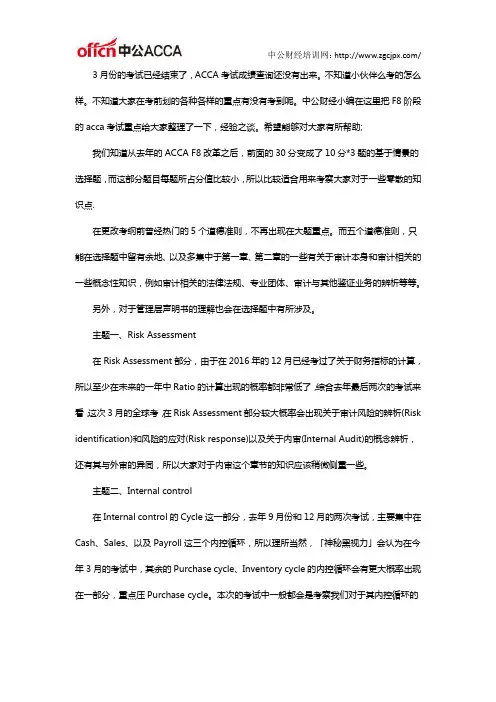
3月份的考试已经结束了,ACCA考试成绩查询还没有出来。
不知道小伙伴么考的怎么样。
不知道大家在考前划的各种各样的重点有没有考到呢。
中公财经小编在这里把F8阶段的acca考试重点给大家整理了一下,经验之谈。
希望能够对大家有所帮助;我们知道从去年的ACCA F8改革之后,前面的30分变成了10分*3题的基于情景的选择题,而这部分题目每题所占分值比较小,所以比较适合用来考察大家对于一些零散的知识点.在更改考纲前曾经热门的5个道德准则,不再出现在大题重点。
而五个道德准则,只能在选择题中留有余地、以及多集中于第一章、第二章的一些有关于审计本身和审计相关的一些概念性知识,例如审计相关的法律法规、专业团体、审计与其他鉴证业务的辨析等等。
另外,对于管理层声明书的理解也会在选择题中有所涉及。
主题一、Risk Assessment在Risk Assessment部分,由于在2016年的12月已经考过了关于财务指标的计算,所以至少在未来的一年中Ratio的计算出现的概率都非常低了,综合去年最后两次的考试来看,这次3月的全球考,在Risk Assessment部分较大概率会出现关于审计风险的辨析(Risk identification)和风险的应对(Risk response)以及关于内审(Internal Audit)的概念辨析,还有其与外审的异同,所以大家对于内审这个章节的知识应该稍微侧重一些。
主题二、Internal control在Internal control的Cycle这一部分,去年9月份和12月的两次考试,主要集中在Cash、Sales、以及Payroll这三个内控循环,所以理所当然,「神秘黑视力」会认为在今年3月的考试中,其余的Purchase cycle、Inventory cycle的内控循环会有更大概率出现在一部分,重点压Purchase cycle。
本次的考试中一般都会是考察我们对于其内控循环的缺陷辨析(Deficiency identification),以及要求我们提出相应地改进或解决方案(Recommend)。
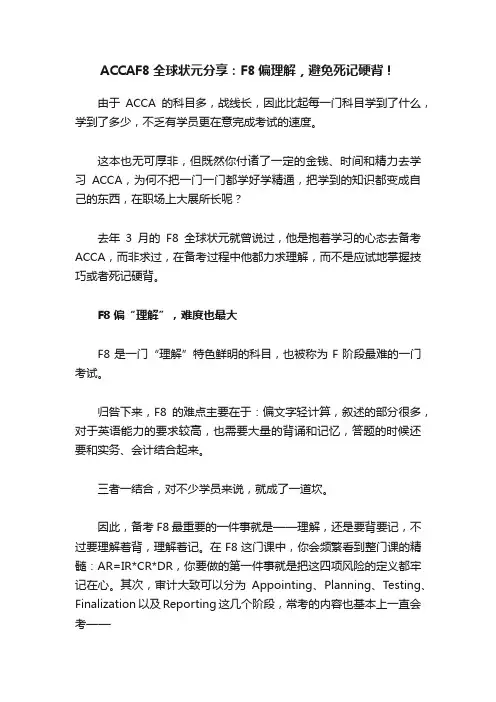
ACCAF8全球状元分享:F8偏理解,避免死记硬背!由于ACCA的科目多,战线长,因此比起每一门科目学到了什么,学到了多少,不乏有学员更在意完成考试的速度。
这本也无可厚非,但既然你付诸了一定的金钱、时间和精力去学习ACCA,为何不把一门一门都学好学精通,把学到的知识都变成自己的东西,在职场上大展所长呢?去年3月的F8全球状元就曾说过,他是抱着学习的心态去备考ACCA,而非求过,在备考过程中他都力求理解,而不是应试地掌握技巧或者死记硬背。
F8偏“理解”,难度也最大F8是一门“理解”特色鲜明的科目,也被称为F阶段最难的一门考试。
归咎下来,F8的难点主要在于:偏文字轻计算,叙述的部分很多,对于英语能力的要求较高,也需要大量的背诵和记忆,答题的时候还要和实务、会计结合起来。
三者一结合,对不少学员来说,就成了一道坎。
因此,备考F8最重要的一件事就是——理解,还是要背要记,不过要理解着背,理解着记。
在F8这门课中,你会频繁看到整门课的精髓:AR=IR*CR*DR,你要做的第一件事就是把这四项风险的定义都牢记在心。
其次,审计大致可以分为Appointing、Planning、Testing、Finalization以及Reporting这几个阶段,常考的内容也基本上一直会考——一、Appointing stage这个阶段最主要还是关于道德的题目。
审计道德的题目,考试频率很高,题型也比较固定,通常题目中会出现特地的场景,比如客户给审计公司送礼之类的。
你要做的就是在高顿题库的历年真题里,把关于道德的题都找出来,然后按照题干给的场景进行情况的分类,对号入座到相应的“五大威胁”,因此整理非常重要。
二、Planning stage1、internal control内控,这基本上是审计当中的固定高频考点。
一般会要你找出控制缺陷,这个把题干中有问题的部分照抄下来就行了,然后会问你这样的内控会导致怎样的风险,接着要你回答你要怎么做才能防止这个内控缺陷的发生,其实这里很奇妙,不用想太多,把前面你所认为的控制缺陷反过来说就行啦,“要”变成“不要”,“可以”变成“不可以”,最后会要求你测试一下你的审计客户是否具备此类内控。

中公财经培训网:/不管你是新手还是老手,但凡还有考试科目没有通过,就应该多了解一下别人考高分的经验分享。
1、这次获得全球*9,你认为是自己哪方面的能力或努力造就了这样的成绩?首先我对于此次考试的态度更多的是抱着学习的心态去准备,而非求过,因此在准备的过程中我都力求理解,而非应试地掌握技巧死记硬背。
F8虽以文字为主,但也必须理解记忆。
我觉得F类的课程我们不应该只求50飘过,50飘过只能掌握一些很浅的内容,不利于较好掌握科目知识,长期这样是不利于P阶段的学习的,也会影响未来工作的后劲。
2、你对F8有什么自己的看法吗?你在备考时是怎么对待这门考试的?这门考试似乎很多学生都觉得挺难的哟!我觉得很多学员觉得F8难主要有几个方面的原因:首先F8考试文字叙述多,对于学员的英语能力要求较高,其次F8偏重文字轻计算,因此理解背诵内容较多,掌握起来不比模式化的计算简单,最后F8是与实务和会计知识相结合的,缺少相应的知识会增加F8备考学习的难度。
我认为F8十分重视逻辑,而审计逻辑的精髓就在于审计风险公式,任何F8的知识和审计的工作都是围绕这一公式展开的,所以把握好审计风险公式就把握了审计逻辑的精髓。
3、你已经通过ACCA前九门了,后面的几门P打算如何规划考试时间?也是保持之前的节奏吗?为什么?关于以后P阶段考试的规划,我会选择每次以1到2门搭配进行考试,考试的进度我想还是会维持现在这样较慢的速度,以此保证每科的学习都能学懂学透,为以后的工作奠定良好的基础。
4、你的目标是考研?为什么会确定这个目标呢?那你是如何平衡ACCA考试和考研呢?是的,我的目标是考研,确定这个目标主要原因是为了获得一个更好的平台,以此来进一步提高自己的专业知识水平,积累重要的人脉,为以后的工作和生活养成一种良好的做事和思考习惯。
关于ACCA和考研的平衡,因为初试需要大量时间和练习的准备,如果报ACCA我无法较好的兼顾,但因为复试时要考专业英语和审计,因此我借机一起准备F8 为复试做准备,也因为以复试的高标准准备F8 力求弄清每个细节,所以才能取得高分。

ACCA知识点:F8理解审计战略和审计计划在ACCA考试中,F8当中理解审计战略和审计计划一直是大纲中最为重要,也是难点最多的一部分知识点。
那么今天就为同学们总结一下F8当中理解审计战略和审计计划的习题讲解,这部分内容体系比较复杂重要,所以帮助大家做些题目逐渐了解这章内容。
Audit is a subject where sharp minds can excel. What is really demanded of us is understanding ‘materiality’. As simple as it sounds, it can be the reason why many students might fail paper F8. The first question was about Audit Strategy. And ‘materiality’ was definitely a part of it. Do you know the role of the audit strategy and audit plan in defining materiality?Audit strategy and materialityAn audit strategy outlines the OBJECTIVES of the audit that is to be performed – like crafting the skeleton of a body. The details are yet to be filled in.Once the internal control environment and the risk assessment system of the entity is understood, the independent auditor then needs to define an OVERALL materiality level. This consists of two important components:Performance Materiality, andTolerable Misstatement ErrorThe auditor defines each of the two components. The performance materiality aswell as the tolerable misstatement error differs from organisation to organisation, market to market and economy to economy.Audit plan and materialityThe audit plan is an important document. ISA 300 is the governing standard here. The audit plan provides guidance on:The directionThe supervision, andThe review of audit proceduresWhile going through ISA 320 – Audit Materiality in the study text, I ran a few searches online, discovering that the US regulates its audit procedures under Statements on Auditing Standards (SAS). These are a collection of Generally Accepted Auditing Standards (GAAS).I opened SAS 122, section 320, which was titled Materiality in Planning and Performing an Audit. There, I found what I was looking for – the audit plan:Helps give the auditor insight regarding the effect of the nature of an organisation in defining materiality.Helps outline situation-based factors influencing the materiality.Allows the auditor to take in account several other factors to establisheffective materiality levels.Lets the auditor document any changes/revisions in the materiality level initially defined by the auditor if crucial evidence is found later on at the performance stage.Takes into account any possible changes to the performance materiality level following any change/revision in the overall materiality level.As part of the ACCA student network, we all need to understand the basics of audit firmly to excel in our careers. I believe ACCA studies do not just keep you confined to one book in your bag, but demand you to research on your own.I would love to hear your thoughts on this. Let me know if this article has helped you on your path to success in Paper F8.获取更多ACCA考试知识点可关注永和九年,岁在癸丑,暮春之初,会于会稽山阴之兰亭,修禊事也。
上海总部地址:上海市虹口区花园路171号A3幢高顿教育
电话:400-600-8011 网址:
ACCA 考试:F8新题型的评估
本文由高顿ACCA 整理发布,转载请注明出处 Audit and Assurance(F8)新题型的评估:
1.Good News:
在ACCA 的官网上,有一套叫作“Specimen Exam applicable from December
2014”的题目。
我也为考生们附在这仹考纲解析的后面了。
有兴趣的同学可以试着做一下,有标准答案的。
虽然你们中的很多人可能还没有开始F8的正式学习,但是你们可能已经可以回答上好几个问题了。
希望这也能够增强大家通过F8考试的信心。
所以仍题目本身看来,在第一个SECTION 里,以选择题取代原来的简答题,为考生提供了四分之一答对的可能性;在第事个SECTION 里,长题目可能又为考生提供了一步一步,一个 REQUIREMENT 一个 REQUIREMENT 得分的可能性,而 PASS MARK 还是50分。
2.Not good News:
F8是一门有一些重复的课,新考纲迚一步的简化,所以考生们就更加的需要全面复习,重点突出。
而由于一两个知识点的强项掌握而重复得分的情况不会很多了。
更多ACCA 资讯请关注高顿ACCA 官网:。
《安徽水利财会》2016年第3期知识视窗A C C A Paper F8(英国特许公认会计师协会资格认证考试科目之审计与鉴证业务)的考官为了全面考查考生对于期末复核阶段审计知识点的掌握情况,倾向于在最后一道案例分析题中将期后事项(subsequent event)的判断和审计以及持续经营能力的评价和审计这两个重要的知识点进行轮换出题。
发现这一出题规律并不难,为什么还是有许多考生对期后事项复核望而生畏、失分严重呢?难点就在于期后事项的内涵、期后事项对财务报表的影响以及期后事项复核的审计责任三个方面。
一、期后事项的内涵和期后事项对财务报表的影响(一)期后事项影响财报的判断流程根据国际会计准则第10号(1A Sl0)的界定,期事项是指在财务报表日和财务报表批准报出日这一时段之间发生的经济事项。
财务报表批准报出日,是指董事会或类似机构批准财务报表报出的日期,一般与管理层签署已审计财务报表日和审计师签署审计报告日为同一天。
既然审计报告日滞后于财务报表日,审计师为了验证一个会计期间的财务报表的真实公允性,除了针对被审计年度的交易和事项执行充分必要的审计程序之外,还需要认真斟酌财务报表日之后所发生的事项对被审计年度财务报表的影响程度,并且做出财务报表是否需要修改的判断,具体流程如下图1所示:(二)判断财务报表是否需要修改的两个步骤1.辨别事项是否对财务报表日已经存在的情况提供更深入的证据。
期后事项包括调整事项(adj ust m gevent)和非调整事项(non-adj ust m gevent)。
若期后事项对财务报表日已经存在的情况提供了新的或更深入的证据,则该事项为调整事项,否则是非调整事项。
调整事项的特征是:在财务报表日或以前就已显示出某种征兆,但最终结果需要在财务报表日予以证实。
财务报表日后调整事项包括下列各项:财务报表日后发现了财务报表舞弊或差错;未决诉讼在财务报表日后结案;财务报表日后有证据表明需要对财务报表日的某项资产计提减值准备或者需要调整之前确认的减值金额;财务报表日后有新的证据需要重新确定财务报表日前某项资产的购置成本或者销售收入。
ACCA Paper F8考点详解——关于审计报告
陈丹
【期刊名称】《财会月刊(会计版)》
【年(卷),期】2015(000)007
【摘要】考生对ACCA Paper F8的考点之一——审计报告不甚熟悉,一定程度上造成该科目全球通过率低.考生应掌握审计报告的基本术语、划分方式以及审计意见类型.其中,审计报告的基本术语包括错报、重要性、广泛性、审计范围受到限制;划分方式有两种:格式和审计意见类型;通过依次回答以下三个问题可对审计意见类型做出判断:被审计单位财务报表是否存在(潜在)重大错报?(潜在)重大错报是否具有广泛性?审计范围是否受到限制?
【总页数】3页(P115-117)
【作者】陈丹
【作者单位】江西财经大学会计学院,南昌330013
【正文语种】中文
【相关文献】
1.ACCA Paper F8考点详解——关于持续经营假设复核 [J], 陈丹
2.ACCA Paper F8考点详解——关于期后事项复核 [J], 陈丹
3.ACCA Paper F8双语教学的思考 [J], 陈丹
4.ACCAPaPerF8考点详解 [J],
5.专业英文选词在ACCA案例分析中的应用——以F8科目学习为例 [J], 查研
因版权原因,仅展示原文概要,查看原文内容请购买。
技巧丨ACCAF8 Audit and Assurance (AA)审计实质性程序的答题技巧F8审计实质性程序的答题技巧每季度考试季,大批的ACCAer像赶鸭子上架一样的冲进了考场,有盲目或不盲目的把答题卷填完,甚至不够写还要了第二本。
那么考生们落笔下去的每一句话是否都达到了考官的得分要求呢?有些同学在答题的时候特别能扯,但是也许这样的行为只是浪费墨水而已。
更有些同学发现答题时间根本不够,考试结束的时候还留下了一些那么个题没答完。
快准狠!「神秘的黑视力」传授秘籍教你如何在 F8 审计与鉴证这门课对答如流首先记住关于某个科目给出多个审计实质性程序也就是Substantive procedures这是这门长篇大论的分值最高的点(帮主插话:就叫他high点吧)套路不深,功夫要真那么在写实质性审计程序的时候,是有套路和方法的。
如果程序写得不够明白,并非明确,一句看似正确的回答方法是得分无效的。
举个栗子在会计师事务所里,工作量最大的一个动作无非是查发票,这是一个极其常见的动作。
那么英语姿势水平有待提高的童鞋会这么耿直的回答。
The auditor should checksales invoice.老师只能摇摇头,在这句找不到语法错误拼写错误的句子里,得到的分数也是零鸭蛋。
这样的一句话中出现的关键词汇是发票,可是Check这个动词对invoice来说所包含的含义实在是太广泛了,我们国家是税务大国,在一张小小的发票上可以读出的信息量可不是一般的大。
首先,一张发票可以判断其发生的金额是多少。
其次,从摘要内容上可以读出这是一个什么类型性质的经济行为以及其发生时间,以及在命题中所讲的sales invoice 一定会显示销售出去的产品名称、类型、单价和数量。
当然还有此类发票的税基、税率。
最值得一提的是发票编号,我国的发票管理可以精确到没有一张发票的编号是重复的等等,这些信息完全被这样的英语表述用check一个词一概而论,含糊其辞,考官实在是不好意思给分啦。
学会巧妙运用ACCA真题顺利通过F8考试ACCA历年考试,真题的重要性我想大家都不言而喻,下面我们就谈谈如何运用ACCA F8真题来帮助我们顺利通关F8科目的考试。
ACCA F8科目介绍:F8《审计与鉴证业务》分为4个部分:1.介绍鉴证服务的特性、目的和范围,包括法定审计、规范环境以及和审计不鉴证相关的职业道德;2.介绍内部审计,包括内部审计的范围和内部审计不外部审计的差异;3.大部分内容都是在介绍如何对财务报表进行审计。
这些包括计划、风险评估、评价内部控制、手机审计证据以及财务报表的复审;4.最后是对报告的处理,包括法定审计报告、管理报告和内部审计报告。
F8课程是ACCA基础课程阶段唯一的一门关于审计的课程,它详细介绍了对财务报表的整个审计流程,与F8直接相关联的课程是专业阶段的选修课程P7(高级审计与鉴证)。
同时,F8也与F4、F7和P1课的部分内容有间接联系。
ACCA F8学习方法:ACCA F8历年真题是关键。
虽然ACCA考题重复出现的可能性比较小,但真题体现出的侧重点、各部分的比例,在主考官不变的情况下大都会保持一致。
对于审计科目,我在考前把2005年6月以来的几套题反反复复研究了好几遍,我认为仅仅看考题是不够的,需要从考题的案例中猜测考官的出题意图,分析考官答案的侧重点,以及每个知识点的表述方式。
一般在考前的两三个星期,也就是对基础知识有了很好的把握之后开始研究真题,因为真题内容往往比较综合,学习之初直接看真题可能会有一定的难度。
抓大放小为捷径。
在第一遍的学习中,因为时间相对比较宽裕,大纲中的每个知识点都要有所关注,并理解透彻,如果时间允许,也可以对大纲以外的相关内容进行了解。
而在考前时间比较紧的情况下,可以专攻重点,这样便可轻松地应付考题中涉及的重点知识;对于考题中相对偏的知识点,也可以根据第一遍学习中的印象答上几点,不至于某个问题完全不会答。
考官文章要重视。
考前四五天,建议大家上网搜寻最新的考官文章,如果有的话,可将文章中提到的知识点回归课本。
中公财经小编给大家介绍过ACCA很多科目的考试。
但是关于F8阶段的考试似乎讲的不太多,下面就让小编给大家简单介绍一个考F8的成功的经历吧。
希望能够对大家接下来6月份的ACCA考试有所帮助。
F8是ACCA技能阶段科目中较难的一个科目,有着八十分问答题和许多专业词汇,对于很多备考的考生来说也是备尝辛苦的,下面就为大家总结一下ACCA F8的考试技巧,希望对大家更快地学好ACCAF8!首先,你要记住“F8绝对不是背出来的,也不需要玩命地刷题”。
理解知识点最重要!刷题次之。
如何去理解审计,这对于很多大学生,还有未接触过审计的学员来说是极其困难的。
这里为大家提供了一个非常好的方法:把自己处在审计师的环境,努力的去理解对于审计过程在这个阶段的目的,意义,然后在自己没事的时候,就问自己,为什么审计师要做这个事情,这样做的目的是什么,以及会带来什么后果。
比如:审计师为什么要要遵循IAS 315理解企业环境,然后就开始问自己:(1)理解企业环境的好处?(2)审计师理解了企业环境之后,要怎么做?(3)然后审计师要做什么,怎么做?(4)如果对企业环境理解正确了,会对审计报告有啥影响?(5)要是理解错误了,对审计报告有啥影响?没事的时候随意的问自己,想起什么问题就问,直接问到审计报告阶段,不会的就去翻书,思考整个审计过程。
检验是否理解知识点的唯一标准,就是要有的答才可以,这样考试自然就能答出来了。
理解之后便是如何答题,如何找到问题对应的答案。
这个时候就需要按部就班地开始做历年考题!第一,理解考官在考你什么,他的出题思路;第二,凭着自己对习题的理解,先做一遍,然后再跟考官答案作比较,找出原因,找出差异;第三,就是消除自己的错误思想,去其原来脑中的糟粕,取其精华,这步就是你如何pass的阶段。
刚开始一定会很痛苦,天天都绞尽脑汁。
但是坚持这样虐待自己之后,你就会觉得有效果,到最后,可以把整个审计过程串联下来了。
到考试前,也不需要做很多题,但是对审计的过程理解的却很是透彻!另外对于那些有书写障碍的学员,就需要多做ACCA历年真题,在答题和阅读标准答案中不断提高自己的写作能力。
对于ACCA考试科目中F8的题型分析
关于ACCA考试科目中,各科都考哪些题型呢?中公财经网小编就以F8为例给大家简单介绍一
下吧。
(一)客观题(Objective test questions/OT questions)客观题是指这些单一的,题干较短的,并且自动判分的题目。
每道客观题的分值为2分,考生必须回答的完全正确才可以得分,即使回答正确
一部分,也不能得到分数。
(二)案例客观题(OT case questions)
案例客观题是ACCA引入的新题型,每道案例客观题都是由一组与一个案例相关的客观题组成的,因此要求考生从多个角度来思考一个案例。
这种题型能很好的反映出考生将如何在实践中完成这些任务。
案例客观题会出现在2016年9月份的笔试中,这意味着CBEs考试和笔试的格式在本次考试中将完全一致。
(三)主观题(Constructed response questions/CR qustions)考生将使用电子表格程序和文字处理程序去完成主观题的回答。
就像笔试中的主观题一样,答案最终将由专家判分。
今天就奉上同学回忆出的12月ACCA F8科目考试真题,勇敢的童鞋赶紧来测试一下,你到底能否考过F8吧!
Section A部分真题
第一道案例选择题印象比较深,是关于professional ethical,考了fundamental professional
ethical和threat。
第二道是关于payroll system,考了audit procedure,completeness,understatement test,其中还有一道计算payroll expense。
第三道问了audit opinion,还有SP,有overstatement test。
Section B部分真题
第一道大题,有16分的audit risk(identify and response)找出8个,factors to
consider set up internal audit department 4分,how internal audit effect
on fraud and errors 2分,SP hot review and cold review 4分,SP for wages and
salary on completeness and existence 4分。
第二道大题考了SP on inventory count,分为before and during共6分。
receivable
overstatement,问whether the financial statement need to be amended 4分。
if
not amend,the impact on audit report4分。
SP for sales and returns
第三道大题考的是sales and despatch system,control objective of the system 4分。
deficiency and recommendation让列出7个,14分,cover letter2分。
最后,关于ACCA考试科目中,F8的考试题型小编就给大家简单介绍到这里了。
如果还有其他ACCA考试相关内容想要了解的,就请登陆中公财经网咨询一下吧。
X。